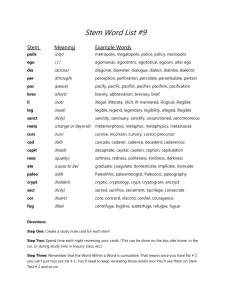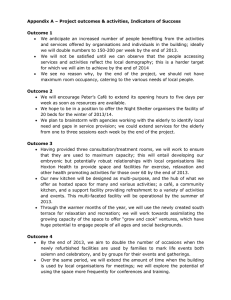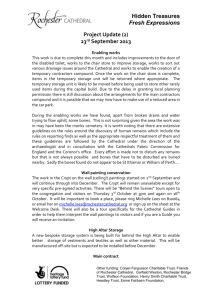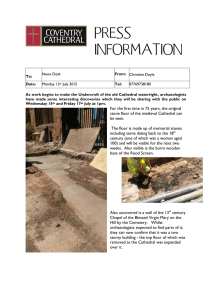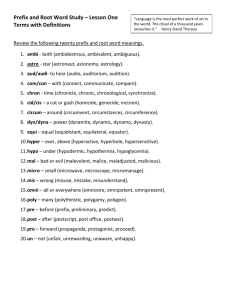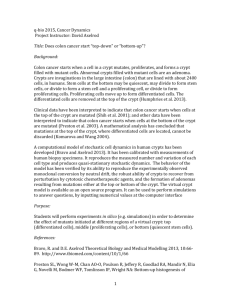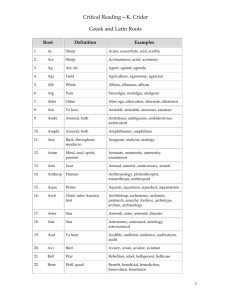Harry B. Titus, Jr. Wake Forest University, 2001
advertisement
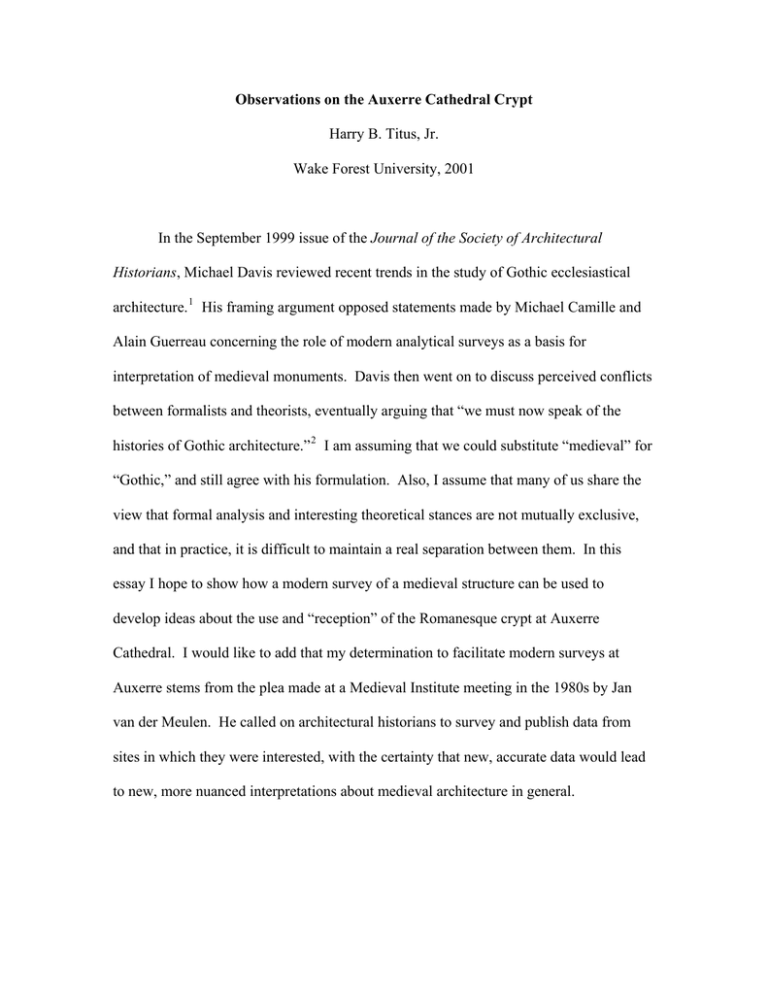
Observations on the Auxerre Cathedral Crypt Harry B. Titus, Jr. Wake Forest University, 2001 In the September 1999 issue of the Journal of the Society of Architectural Historians, Michael Davis reviewed recent trends in the study of Gothic ecclesiastical architecture. 1 His framing argument opposed statements made by Michael Camille and Alain Guerreau concerning the role of modern analytical surveys as a basis for interpretation of medieval monuments. Davis then went on to discuss perceived conflicts between formalists and theorists, eventually arguing that “we must now speak of the histories of Gothic architecture.” 2 I am assuming that we could substitute “medieval” for “Gothic,” and still agree with his formulation. Also, I assume that many of us share the view that formal analysis and interesting theoretical stances are not mutually exclusive, and that in practice, it is difficult to maintain a real separation between them. In this essay I hope to show how a modern survey of a medieval structure can be used to develop ideas about the use and “reception” of the Romanesque crypt at Auxerre Cathedral. I would like to add that my determination to facilitate modern surveys at Auxerre stems from the plea made at a Medieval Institute meeting in the 1980s by Jan van der Meulen. He called on architectural historians to survey and publish data from sites in which they were interested, with the certainty that new, accurate data would lead to new, more nuanced interpretations about medieval architecture in general. Figure 1 Figure 2 At my request, during the summers of 1994 and 1995, Olivier Juffard surveyed the crypt of St. Etienne in Auxerre, producing a new plan and elevation (Figures 1 and 2). Our project was carried out under the auspices of the Centre d’Études médiévales (CEM) in Auxerre, and was financed by a grant from Wake Forest University. Juffard used a laser theodolite that captured reflected light from a small mirror. Measurements in three dimensions were recorded at every change in direction of the crypt’s masonry. The measurements were linked to the French national geophysical survey plug that conveniently happens to be located in one of the cathedral’s west façade buttresses. Therefore, the measured points are located within a larger, standard grid, which means that they are more “objective” than in previous surveys, which often seem to include assumptions about the nature of crypt features that might not be warranted. By this I mean that various original symmetries were assumed, and that later changes to the structure replaced original elements that were of uniform aspect. This plan was created using a CAD program that reconciled 773 measured points, while the elevations required an additional 146 measured points. The procedure permits others to start with accurate, impartial data if they wish to develop alternative interpretations. One of the functions of the crypt was to serve as support for the eastern section of the Romanesque cathedral, and of course it serves today to support part of the Gothic chevet. In 1999 I commissioned the PROGEO surveying firm, based in Avallon, to develop a plan of the Gothic building at floor level. Gilles Fèvre of the CEM added measured profile drawings to the plan to make it more descriptive, a process completed in October 2000. The procedure used to make the plan of the upper church was new; a small amount of light emitted by a laser theodolite was reflected back to the instrument as the beam moved along the masonry and changed planes. The PROGEO staff produced a version of their plan superimposed over Juffard’s crypt plan, calibrated to the same French geophysical grid. As a result, we can understand the exact relationship between the crypt and the upper building. It is interesting to note that surveying and related software technology took a big step forward in the short period between 1995 and 1999. As an added incentive to commission new studies, the cost of surveying a given area has decreased as equipment has become more efficient. Figure 3 The Auxerre Cathedral crypt is important because it is relatively securely dated to 1023-1030, and because it is one of the better-preserved examples of the changes in northern French masonry practices that occurred between 1020 and 1060. 3 It is noteworthy for its plan, its pier/vaulting relationship, its masonry type and treatment, and its frescoed decoration. Éliane Vergnolle has recently characterized the crypt layout as the work of a great architect, noting the absence of a reliquary function, its clear articulation of parts, its medium sized, regularly cut masonry, and its subdued but significant level of architectural decoration (Figure 3). 4 Members of the CEM have recently published technical studies of medieval painting in Auxerre. Emmanuelle Cadet’s analyses of the crypt frescos are presented in the volume Peindre à Auxerre au Moyen Âge, 5 in which a summary of Christian Sapin’s views on the crypt and notes referring to his many studies on crypt typology also can be found. 6 The new crypt plan makes it clear that previously published plans have been regularized to fit the perception so clearly stated by Vergnolle that the crypt is an important work by a great architect. Often the current (post-eleventh-century) entrances are left out so that the plan appears to be completely symmetrical. There has been disagreement about whether the axial chapel should have a curved or squared exterior profile. As is often the case, the assumptions underlying the plans are unstated, but are implicitly accepted by later scholars when re-publishing a plan. Vergnolle’s plan, for example, 7 is regularized and indicates entryways into the crypt through the aisles, although that clearly was not the case in the eleventh century. The new plan attempts to show what exists, so as to separate object from interpretive strategies. The most fundamental problem facing the student of the crypt is its sloping site and flooring. When I first began serious study of the cathedral complex, the most imposing problem was my inability to relate securely one part of the complex to another. It has only been in recent years that I have been able to find the financial support to overcome this impediment through the use of current technology. The crypt plan and elevation, the upper church plan, and the radar and electrostatic studies that have been done in collaboration with my French colleagues have clarified many of my previous interpretations of the cathedral’s features. In short, modern technology has permitted me to understand medieval practices and goals more clearly. Fittingly, the eleventh-century decision to build on a sloping site (northwest to southeast), rather than to level the terrain, caused problems for the builders and problems for modern interpreters of the crypt. The crypt problem starts from the ground up; everything within it was conditioned by the sloping site. My hypothesis about the long-term development of the site is that the Carolingian structure, presumably burned in the fire of 1023, was located to the west of the present crypt. The new, larger extent of the eleventh-century cathedral was achieved by expanding to the east, down the slope toward the bishops’ residence and the river. 8 The crypt represents that new eastward extension. It was built to support a new sanctuary whose floor level was apparently determined by the level of the damaged Carolingian building. Later in the Gothic period, when a decision was made to keep the crypt and build a new sanctuary following its plan, lengthening the cathedral was accomplished by building a new façade considerably to the west of the Carolingian/Romanesque façade. The result is that, somewhat unusually, the visitor descends from the west portals toward the eastern sections of the cathedral. The underlying issue is that one of the most evident features of the crypt plan is its extension toward the west in the central crypt by two bays beyond the end of the aisle/ambulatory. While the eastern four bays of the central crypt are of relatively uniform dimensions (+/- 5 cm), the western two bays are significantly smaller in length (as much as 60 cm) and more irregular in layout. Their piers and wall responds are out of alignment in the north-south sense, which further differentiates them from the eastern bays. My interpretation is that the new eastward extension of the cathedral created a need to “reach back” toward the old site so that interior communication with the upper church could be maintained in a traditional location. Therefore, the western two bays seem to provide a link between new construction related to the Romanesque sanctuary and a previously fixed point represented by the west wall of the crypt. In other words, the building that burned in 1023 included some structure on the site of the extant crypt. The west bays of the central crypt are especially interesting because they include four medieval entrances, now all walled in. Two entered through the west walls of the north and south bays, and two more entered these same bays through their lateral walls. The masonry in the northwest corner of these bays, where it is original (the corresponding southwest section was reworked in the post-medieval period), indicates that all four entrances were tied into the original eleventh-century crypt program. However, the two entrance sets, longitudinal and lateral, are quite distinct from one another. The longitudinal entrances link to sloping, vaulted passages that evidently connected the crypt with the central space of the upper church. Sloping barrel vaults cover the visible sections, and a modern, sloped glacis presumably covers steps. 9 The two openings into the crypt do not fill the space available between wall responds, they are not the same size, and they are not symmetrically located in relation to the crypt. The south entrance’s south wall is actually aligned slightly beyond the central crypt wall plane. As argued above, this seems to indicate that there were connections between the upper church and a lower structure that pre-dated the fire of 1023. These two passages were partially filled in shortly before 1530, when the foundations for a new jubé were laid. 10 The lateral entrances, whose character is most clearly visible in the unrestored north bay, filled the entire extent of the bay wall, to the point that the arch associated with the entrance rises above the eventual vaulting line. These two entrances are clearly integrated into the wall system of the crypt. They linked to curving stairs that connected the crypt with the side aisles of the upper church. It seems, then, that the crypt as conceived in 1023 included a set of privileged (pre-existing?) entrances from the sanctuary area, and a set of “public” entrances from the side aisles. The lateral two entrances were filled in as part of the Gothic chevet project of ca. 1215-35, since the new pier spacing of the Gothic structure caused a pier to fall directly above the entrances. The masonry blocks that fill the entrances are of the same type that are found in the exterior chevet buttresses. The four entrances were the original means of access into the eleventh-century crypt. However, since we are discussing entrances, there are three later examples to review briefly. Bishop Robert of Nevers (reg. 1076-1084) had a pair of openings made into the northeast bay of the ambulatory, giving on to the episcopal courtyard. 11 The remains of their framing arches are still visible, although they too were walled up later. On the south side of the crypt an entry was made from the canons’ enclosure, passing between the chevet buttresses into a large, barrel-vaulted chamber beneath the chevet side aisle and into the south crypt ambulatory. This entry is undocumented, but its masonry has a late medieval character. Currently, visitors enter the crypt through this entrance. Further east, post-medieval connections have been made between the south crypt ambulatory and the substructures of Gothic side chapels. Finally, in 1926 a stairway and passage were constructed to connect the north chevet aisle with the north crypt ambulatory. 12 During this construction a base of the upper Romanesque building was uncovered, and that building’s floor level was also revealed about 30 cms beneath the Gothic paving. All these elements are indicated on the new plan. In earlier plans these two very consequential western crypt bays were usually drawn without indications of their complex surrounding elements. The eastern four central crypt bays are relatively regular, as noted above. The curve of its eastern terminus was swung from a point that does not relate directly to the pier placement system. Compound piers, one of the most frequently cited features of the crypt, are aligned on an axis skewed slightly from northwest to southeast in relation to the axes of the enclosing walls. Their alignments are less consistent in the north-south than in the east-west direction. The responds along the curving eastern enclosure were placed in position in order to line up as well as possible with their counterparts on the compound piers. While the curve of the ambulatory walls was swung from the same point as the inner crypt wall, the dosserets in the ambulatory were placed according to a system that is not related to the respond system in the central crypt. There are substantial differences in dosseret designs between the north and south ambulatory bays. Also, there is a slight shift in axis between the central crypt and the axial chapel. At this point we can reflect that Vergnolle’s “great architect,” and I agree that such is the case, had problems in relating the articulation of the ambulatory to that of the central crypt, and faced the integration the compound piers into the overall design somewhat hesitantly. The evidence indicates that the crypt was conceived as a unit, but that adjustments were made to overcome site problems, resulting in significant irregularities in plan. Turning to the elevations, the consequences of building on a sloping site are more dramatic. The present crypt paving dates to Viollet-le-Duc’s restoration campaigns in the crypt in 1844. 13 A contemporary observer, M. Quantin, wrote “on a cru devoir daller les cryptes pour cacher la nudité du roc sur lequel elles ont assises.” 14 The difference in paving level between the high point in the northwest central crypt bay and the low point in the axial chapel is .995m. Within the central crypt the difference between the same highest point and the lowest point in the southeast curving bay is .704 m. At present there are steps between the paved side aisle bays and ambulatory, making it difficult to speculate about their original disposition at ground level. The compound piers in the central crypt are seated on round platforms whose evident purpose is to regularize the sloping bedrock beneath them. The piers’ first course is a chamfered “base” element that is very uniform in size throughout, between 20.5 cm and 22 cm in height. The continuous imposts at the summit of the piers are equally regular, between 18.5 cm and 21 cm in height. Thus, in the decorative elements of the cruciform piers there is a level of uniformity and “quality control” in the +/- 3 cm range that meets modern expectations for the emerging, eleventh-century employment of moyen appareil masonry. Their regular pattern of joins and the regularity of the longitudinal and transverse arches that link them and the wall responds support this impression. We are again face to face with Vergnolle’s “great architect.” On the other hand, none of the pier imposts shares a common horizontal level. The overall difference in levels in the present paving of 70 cm is halved to a range of 34 cm at the top of the imposts. Then, at the summit of the central crypt groin vaults, none of which share a common horizontal level, the range increases to 46 cm. Therefore, if we Figure 4 posit that the Romanesque upper sanctuary had a level floor surface, that horizontal was established either by manipulating the rubble construction of the vaults (which have a minimum thickness of 1.55 m) or by a leveling course above them. The “architect” attempted to address the issue of horizontal uniformity by varying the sizes of the middle courses of the crypt piers, but without achieving his goal. In the north exterior wall of the second central crypt bay from the west, the only undisturbed wall surface in the central crypt, another approach to the same problem is visible (Figure 4). The infill walls are composed of moellons, the older masonry technique that contrasts with the moyen appareil used in the piers and arches. The third course above the sill is a leveling course, in which there was an attempt to establish a horizontal with the second moyen appareil course seen at the left, but without success. At the fourth course on the left they tried again, and again at the sixth, but to no avail. The final effect of this leveling problem is that the vaults are very irregularly related to the wall arches throughout the crypt. In fact, a common horizontal level was never achieved in the crypt program. Our builders attempted to fuse two masonry practices with a new relationship between support and vaulting that was ambitious, but fell somewhat short of mastery. This situation is analogous to the successes and problems discussed above concerning planning concepts. A fundamental question that remains to be answered by further study beneath Viollet-leDuc’s paving is why the bedrock was not leveled at the beginning of such an extensive project, and what its surface can tell us about the early history of the crypt. Viollet-le-Duc’s restorations of the crypt in the 1840s included shrinking a number of the openings through the wall between the central crypt and the ambulatory. The eleventh-century disposition remains only in the northwestern bay, the axial bay, and the two bays immediately adjacent to the axial bay on the south. The remainder were later enlarged, but were restored to a more symmetrical presentation by Viollet-le-Duc. Christian Sapin has observed that the axial opening, with its central column, probably was flanked by similar arrangements, since in the adjacent south bay traces of small arch departures survive. Such a disposition is consistent with the size and shape of the openings, supporting Sapin’s argument. On the north, the aisle and ambulatory exterior walls were later reworked, closing the twin entrances that Bishop Robert had made in the later eleventh century. The exterior profile as indicated on the plan is a function of the new, Gothic chevet. In the thirteenth century the crypt masonry was enclosed within a Gothic envelope in order to build a somewhat wider upper church based on the crypt’s plan. Therefore, the only indication of the Romanesque exterior wall thickness comes in the northwest aisle bay, which boasts the only untouched eleventh-century window. Since a treasury was erected against the Romanesque cathedral at this location before the Gothic rebuilding program began, the window was never enlarged. The lower wall of the treasury is visible abutting the window’s exterior frame. The thickness of the masonry from the interior wall surface to the exterior surface is 1.20 m, which represents the minimum Romanesque exterior wall thickness. By comparison, the cross sections of the central crypt piers are on the order of 1.25 m, and the wall cross section between the central crypt and the aisles/ambulatory is on the order of 2.05 m. Thus, the “power” of the crypt structure is focussed on the wall between the crypt and the aisle/ambulatory, that is, the most technically traditional part of the ensemble. The Romanesque cathedral was consecrated in 1057. 15 It is likely that by then the bulk of construction had been complete for some time. The bishops of the later eleventh and early twelfth centuries concentrated on the cathedral’s decoration. 16 In the 2000 sessions at the Medieval Institute, much was said concerning the “performative” nature of medieval art. However, in its early existence, the Auxerre crypt seems not to have functioned as that type of space. Instead, it served the utilitarian function of supporting the “performative” space above it. The earliest documentary discussion of crypt decoration comes during the episcopates of Robert of Nevers and Humbaud, that is, during the last quarter of the eleventh century. Perhaps this is the reason that the bedrock was not leveled; the crypt was “constructive” and not “liturgical,” a distinction that was made by F. Deshoulières. 17 Its aspect and reception in the twentieth century have been influenced in large measure by Viollet-le-Duc’s paving. The paving gives the crypt a sleek, planar character that certainly was not a part of its medieval aspect, and encourages us to consider it to be a more finished architectural product than it apparently was intended to be. The recent, thorough examination and analysis of the crypt’s painted decoration points toward a date ca. 1100, during Humbaud’s tenure, for the majority of the painted Romanesque remains. 18 The most famous remnant is the equestrian Christ ensemble in the barrel vault of the axial chapel. 19 More pertinent for this discussion are the two partially frescoed transverse arches in the aisles/ambulatory. They are located, 1) on the arch between the northeast turning bays, and 2) on the arch between the southeast straight bay and the first south turning bay. 20 The CEM team dates the former to the same period as the Christ fresco, and the latter to a different campaign based on technical considerations. Nonetheless, both date to Romanesque campaigns of decoration. The two partially painted arches share an important characteristic. Both are plastered and decorated on their western halves; each has a sharp line of demarcation in the middle of its respective arch. I interpret this to indicate that the side spaces were closed off at these points as the crypt came into liturgical use. Chapels begin to be mentioned in Humbaud’s life, with a Trinity dedication in the axial chapel and another to St. Nicholas elsewhere in the crypt. 21 Cuttings into the interior surfaces of the two eastern piers in the central crypt indicate that a barrier was erected across it as well. My hypothesis is that as the crypt came into liturgical use in the late eleventh century, it was divided functionally into two parts. The eastern ambulatory bays and the axial chapel became one unit, accessed by Robert de Nevers’ doorways in the northeastern turning bay, and were under the Bishop’s control. 22 The central crypt and the western sections of the aisles were the second unit, accessed from the interior of the upper church, both from its choir and its side aisles, and were controlled by the chapter. There would have been no formal passage between them. Later in the history of the crypt the connecting openings between the central crypt and the aisles in the chapter’s western sections were enlarged. I believe this modification indicates a change in function to a storage area. The present entrance into the crypt from the chapter side of the cathedral is probably to be associated with this new purpose. At the time it was opened, the small western connectors to the choir were the only means of chapter access, the larger side entrances having been closed in to support the piers of the Gothic chevet. The present entrance opens into the crypt aisle through a large, barrel vaulted room beneath the chevet side aisle that is far too large to function as an access corridor; instead it has all the characteristics of a storage space. At the Revolution and afterwards, documents tell us that the crypt was used for storage. 23 The changes to its architecture serve the purpose of moving large objects within its spaces. It remains to be determined when this change was made, but I believe that the crypt probably functioned as a “cellar” by the late Middle Ages. The crypt at Auxerre Cathedral originally was conceived to support a new, enlarged sanctuary on a difficult, sloping site. It was “received” as a platform in its early years, but then was endowed with liturgical functions that divided it into sections. Décor was added to support the new functions. However, the functions were never solidified by the existence of important relics, and at some point its liturgical use was modified toward a storage function. In the nineteenth and early twentieth centuries the crypt became an important “example” of Romanesque architecture at its formative stage of development, and was remodeled to emphasize the precocious nature of Burgundian Romanesque practices. Most recently, like most monuments of its type, it has become a tourist venue, the one section of the cathedral that requires a paid admission of the visitor. Questions concerning the function and reception of the crypt were crystallized thanks to the measured survey. The collected data generated issues of a material nature that were difficult to envision earlier. Along with the technical studies of the paintings carried out by the CEM, the data provides a body of material that exists independently of interpretation. As I argued at the beginning of this essay, it represents a procedure and outcome that can help to resolve the perceived methodological divisions as characterized by Michael Davis. One more observation: it is very fashionable to search for geometric congruity in the planning of medieval buildings. In my own experience, and certainly the Auxerre Cathedral crypt provides a fine example, it is the geometric incongruities that often lead to an understanding of medieval reasoning. The “great architect” of eleventh-century Auxerre had a particular program presented to him; he was to build a new, larger cathedral to replace a building that had burned, but the crypt, the extant remnant of that cathedral, was not its primary focus. We must keep that in mind when we evaluate his success and shortcomings as a planner and builder. Fame is always fleeting: the eleventh-century cathedral was famously praised for its construction using quadris lapidibus, 24 but by the fourteenth century that same structure was qualified as rudi schemate. 25 Christian Sapin has established the framework for the study of crypt types in Burgundy. 26 He, his colleagues and his students have attempted systematically to analyze Burgundian crypts as part of the program of the CEM in Auxerre. His interests in masonry and tools have been supported by the formation of an équipe of variously talented individuals. Sapin’s organizational skills underly a new precision of observation and interpretation. His belief in collaboration, especially demonstrated by his willingness to bring researchers with complementary backgrounds together, has substantially advanced the study of medieval monuments in Burgundy. It is a model worthy of emulation. Notes 1 Michael T. Davis, “Sic et Non: Recent trends in the Study of Gothic Ecclesiastical Architecture,” JSAH 58:3 (September 1999): 414-423. 2 Davis: 417. 3 The documentary evidence for the dating comes from the mention of fires in the collected lives of the bishops of Auxerre, Ms. 142 in the Bibliothèque Municipale, Auxerre. The manuscript is published as Gesta pontificum Autissiodorensium in L. M. Duru, ed., Bibliothèque historique de l’Yonne (vol. I, Auxerre, 1850): 309-509. The fires are mentioned in the vita of Bishop Hugues de Chalon (reg. 999-1039), 389-92. The fires are not dated in the vita, but they have been associated with fires dated to 1023 and 1036 noted in Paris, B.N. Ms. Lat. 5253, published in A. Vidier and L. Mirot, eds., Obituaires de la Provine de Sens (vol. 3, Orleans, Auxerre, Nevers, [Paris, 1909]): xxxvii. 4 Éliane Vergnolle, L’art romane en France (Paris, 1994): 78-80. 5 Christian Sapin, ed., Peindre à Auxerre au Moyen Âge (Auxerre et Paris, 1999): 226-236. 6 Ibid.: 225, where Sapin publishes our new plan. 7 Vergnolle: 79. 8 The radar and electrostatic studies of 1998 seem to indicate that the Carolingian and Romanesque cathedral facades were coterminus. 9 The sloping passages are scheduled to be uncovered and studied during the summer of 2001. 10 J. Lebeuf, Mémoires concernant l’histoire civile et ecclesiastique d’Auxerre et de son ancien diocèse, Challe and Quantin, eds. (Auxerre, 1848-55): vol. II, 110. 11 Gesta: 400. The crypt paving inside the doorway location is to be taken up for study in the summer of 2001. 12 Auxerre, Archives de l’Yonne, Dossier 75 T 3. 13 Paris, Archives Nationales des Monuments Historiques, Section 1566 bis. Auxerre, Archives de l’Yonne, Dossier 74 T 2. 14 M. Quantin, “Cathédrale d’Auxerre, Origine et déscription des cryptes,” Annuaire Statistique et Historique de l’Yonne (1848): 237. 15 Vidier and Mirot: xxxvii. 16 Geoffrey de Chapallement (reg. 1052-1076), Gesta: 396; Robert de Nevers (reg. 1076-1084), Gesta: 400; Humbaud (reg. 1087-1114), Gesta: 403-404. 17 F. Deshoulières, “Les cryptes en France et l’influence du culte des reliques sur l’architecture religieuse,” Mélanges Martroye (Paris, 1940): 235-237. 18 Peindre à Auxerre: 263. 19 Ibid.: 226-263. 20 Ibid.: 232-236. 21 Gesta: 403-404. 22 Documents inform us that the patronage for the axial chapel came from the Bishops, most clearly Hugh de Noyers (reg. 1183-1204), who established 4 canons in the chapel, Gesta: 410. Their revenues were increased under Guillaume de Seignelay (reg. 1207-1220), and Gui de Mello (reg. 1247-69). 23 Peindre à Auxerre: 228. 24 Gesta: 389-92. 25 Noted in C. Porée, La cathédrale d’Auxerre (Paris, 1926): 15. 26 See Christian Sapin, ed., Archéologie et architecture d’une site monastique (Auxerre et Paris, 2000) for the most current list of citations.

